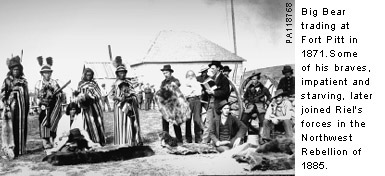



• There was increased conflict between the Algonquins and the Iroquois as they competed for control of the St. Lawrence, gateway for the French fur traders.
• The English system of trading posts (like York Factory and Moose Factory) required the native people to travel great distances to deliver the furs. This changed their normal nomadic movements.
• The French traded differently, going into native lands where they often took native wives and gradually evolved a Metis (mixed race) people.
• The native peoples became dependent on the trading posts for firearms and ammunition and for European food. Because they were devoting most of their time hunting for the fur trade, they didn't have time to hunt for their own food as they had in the past.
• Rather than having an economy based on "shared" food, they now had an economy based on individual profit from furs. Communal hunting grounds started to be divided and the concept of territorial ownership began to take hold in native communities.
• With the fur trade, conservation was abandoned. When hunting for food, native peoples would take only what they needed. Surpluses were not necessary. Now, the fur trade economy meant that the more furs hunted, the more money there was to be made. Eventually this decimated the beaver population.
• The fur trade and European contact also brought the "black robes" - the Catholic missionaries, mostly Jesuits, who came to convert the "heathens." Previously, native religions had been animistic - attributing equal spirituality to all things. People did not have a higher spiritual standing than trees, rocks or deer. This suited the way native people lived with the land.
• The Europeans also introduced alcohol to the native population. This contributed to (and reflected) the demoralization of their culture which was taking place.
• European diseases, for which the native people had no immunity, took a serious toll on native populations.

